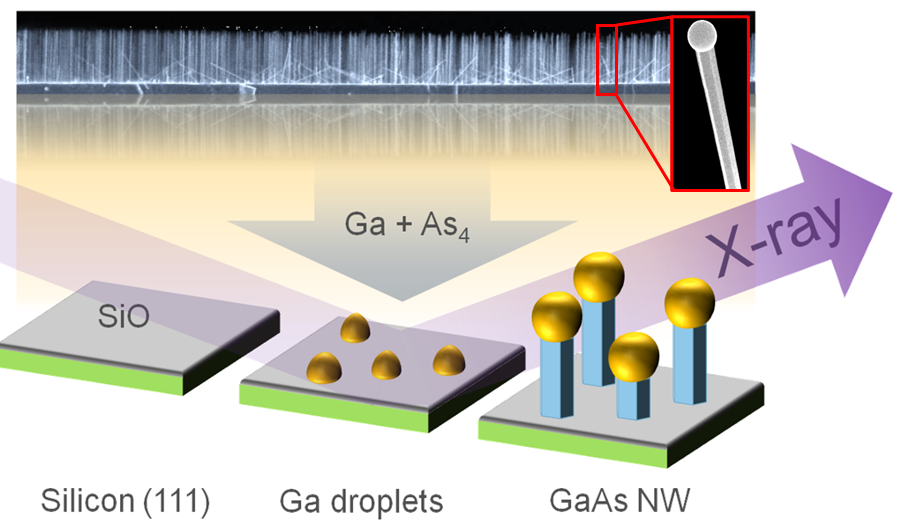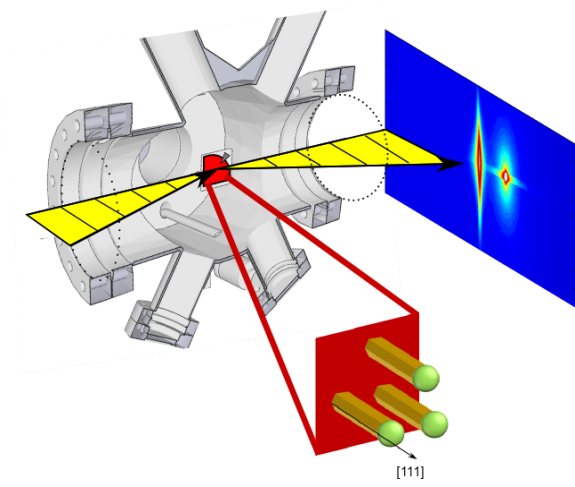In situ Growth & Characterisation of lll-V Nanostructures
The research of our group focuses on the growth and characterization of semiconductor nanostructures in III/V materials systems. Together with the Solid State Physics Group of the University of Siegen, and the Epitaxy Group of the Paul-Drude Institut für Festkörperelektronik in Berlin we currently aim at the growth of self-catalyzed III/V nanowires and their characterization using X-ray scattering methods, especially in-situ.
|
Employing X-ray scattering techniques, we investigate the crystalline properties (e.g. composition, crystallographic phases, lattice strain,and defects) based on the intensity distribution in the vicinity of a set of reciprocal lattice points.
By taking advantage of versatile measurement geometries and the high photon flux we can investigate e.g. structure-sensitive Bragg – reflections which provide unique insight in the evolution of polytypism when applied in-situ.
|
 |
The in-situ investigation of growth processes with X-ray radiation provided by a synchrotron source is a challenging experimental task that requires both dedicated equipment and growth compatible non-destructive characterization methods. In our research we combine growth methods for achieving epitaxial nanostructures and non-destructive, time-resolved X-ray scattering methods. |
|
|
|
For the fabrication of GaAs nanowires we employ a portable molecular beam epitaxy (PMBE) system, based at the KIT Light Source, and optimised for X-ray investigations at a synchrotron beamline during the growth process.
Previous topics of in situ investigations in these materials systems have included:
|
Selected Recent Publications
- Al Humaidi, M.; Feigl, L.; Jakob, J. B.; Schroth, P.; AlHassan, A.; Davtyan, A.; Herranz, J.; Anjum, T.; Novikov, D.; Francoual, S.; Geelhaar, L.; Baumbach, T.; Pietsch, U. (2022). In-situ X-ray analysis of misfit strain and curvature of bent polytypic GaAs-InxGa1−xAs core-shell nanowires. Nanotechnology, 33 (1), Art.Nr. 015601. doi:10.1088/1361-6528/ac29d8
- Jakob, J.; Schroth, P.; Feigl, L.; Al Humaidi, M.; Al Hassan, A.; Davtyan, A.; Hauck, D.; Pietsch, U.; Baumbach, T. (2021). Correlating in situ RHEED and XRD to study growth dynamics of polytypism in nanowires. Nanoscale. doi:10.1039/d1nr02320a
- Jakob, J.; Schroth, P.; Feigl, L.; Hauck, D.; Pietsch, U.; Baumbach, T. (2020). Quantitative analysis of time-resolved RHEED during growth of vertical nanowires. Nanoscale, 12 (9), 5471–5482. doi:10.1039/c9nr09621c
- Schroth, P.; Al Humaidi, M.; Feigl, L.; Jakob, J.; Al Hassan, A.; Davtyan, A.; Küpers, H.; Tahraoui, A.; Geelhaar, L.; Pietsch, U.; Baumbach, T. (2019). Impact of the Shadowing Effect on the Crystal Structure of Patterned Self-Catalyzed GaAs Nanowires. Nano letters, 19 (7), 4263–4271. doi:10.1021/acs.nanolett.9b00380
- Lazarev, S.; Schroth, P.; Grigoriev, D.; Riotte, M.; Slobodskyy, T.; Minkevich, A. A.; Hu, D. Z.; Schaadt, D.; Baumbach, T. (2019). Role of the strained substrate in the x-ray diffraction of free-standing epitaxial nanostructures under grazing incidence conditions. Physical review / B, 99 (19), 195432. doi:10.1103/PhysRevB.99.195432
- Mostafavi Kashani, S. M.; Kriegner, D.; Bahrami, D.; Vogel, J.; Davtyan, A.; Feigl, L.; Schroth, P.; Jakob, J.; Baumbach, T.; Pietsch, U. (2019). X-ray Diffraction Analysis of the Angular Stability of Self-Catalyzed GaAs Nanowires for Future Applications in Solar-Light-Harvesting and Light-Emission Devices. ACS applied nano materials, 2 (2), 689–699. doi:10.1021/acsanm.8b01677
- Schroth, P.; Jakob, J.; Feigl, L.; Kashani, S. M. M.; Pietsch, U.; Baumbach, T. (2018). Lithography-free variation of the number density of self-catalyzed GaAs nanowires and its impact on polytypism. MRS communications, 8 (3), 871–877. doi:10.1557/mrc.2018.145
- Schroth, P.; Jakob, J.; Feigl, L.; Mostafavi Kashani, S. M.; Vogel, J.; Strempfer, J.; Keller, T. F.; Pietsch, U.; Baumbach, T. (2018). Radial growth of self-catalyzed GaAs nanowires and the evolution of the liquid Ga-Droplet studied by time-resolved in situ X-ray diffraction. Nano letters, 18 (1), 101-108, doi:10.1021/acs.nanolett.7b03486
- Köhl, M.; Schroth, P.; Baumbach, T. (2016). Perspectives and limitations of symmetric X-ray Bragg reflections for inspecting polytypism in nanowires. Journal of synchrotron radiation, 23 (2), 487–500. doi:10.1107/S1600577516000333
- Grigoriev, D. A.; Lazarev, S.; Schroth, P.; Minkevich, A. A.; Köhl, M.; Slobodskyy, T.; Helfrich, M. F.; Schaadt, D. M.; Aschenbrenner, T.; Hommel, D.; Baumbach, T. (2016). Asymmetric skew X-ray diffraction at fixed incidence angle: application to semiconductor nano-objects. Journal of Applied Crystallography, 49 (Part 3), 961–967. doi:10.1107/S1600576716006385

